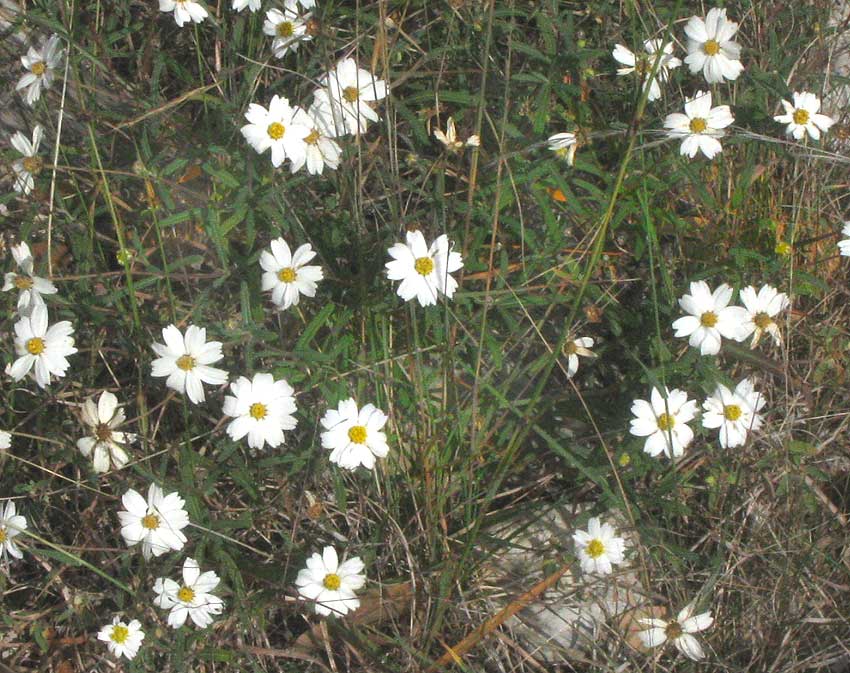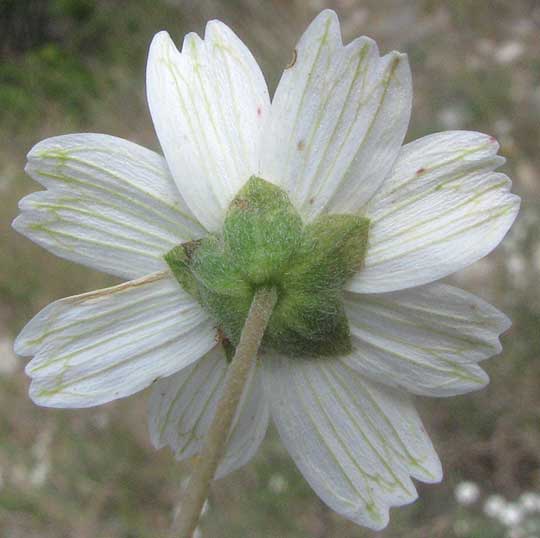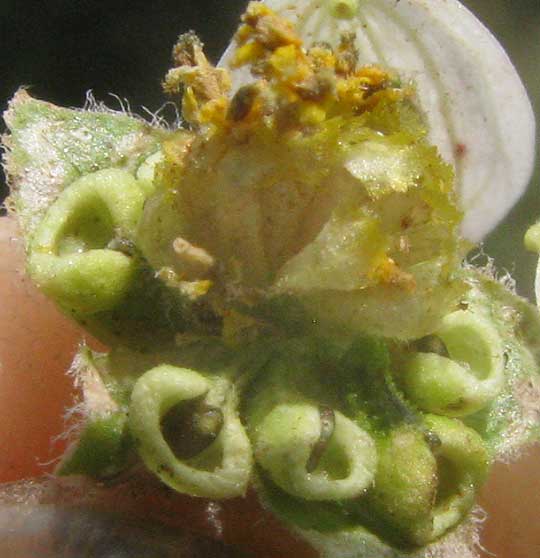Excerpts from Jim Conrad's
Naturalist Newsletter

from the the October 28, 2012 Newsletter issued from the valley of the Dry Frio River in northern Uvalde County, southwestern Texas, on the southern border of the Edwards Plateau; elevation ~1750m (~5750 ft); N29.62°, W99.86°; USA
ROCK DAISIES
In grassy, thin-soiled spots with limestone rocks lying about, among widely spaced Ashe Junipers and Texas Live Oaks on the lower slopes of limestone hills, often you see hundreds of little daisies with honey-scented, yellow-eyed, white flowers arranged so neatly and perfectly that they seem planted there, seem to be horticultural creations set there by someone with an eye for orderliness. You can see a small section of a large colony of this daisy above.
These are composite blossoms, so the white "petals" are actually ray flowers and the yellow "eyes" are composed of numerous closely-packed, yellow disk flowers. All this is perfectly normal for being a daisy, a member of the huge Composite or Sunflower Family.
You start noticing peculiarities about this blossom, however, if you look at it from behind. That's what we're doing below:

Each white ray flower is interestingly notched at its tip, and colored veins ornament the flat corollas. Also, the green involucre subtending the flowers is very unusual for a composite blossom. It looks like the calyx of a flower in a non-composite plant family, like a bowl with five lobes. Composite flower involucres more normally consist of many leafy, strap-shaped items called phyllaries, which overlap one another like roof shingles.
To see really odd field marks distinguishing this genus, however, you have to break the blossom apart and look at its structure, as we've done for a photo that only someone who enjoys flower anatomy could love, shown below:

One thing that that mangled blossom shows is that the yellow disk flowers' maturing ovaries are separated from one another by pale, fingernail-like "paleae" that are jagged or "erose" at their tops. Lots of composite blossoms have no paleae at all, and the vast majority who do have paleae that are not erose.
The second, and most outstanding distinctive feature, are those strange, cup-like things surrounding the disk flowers. They look a little like saddle stirrups with black cucumbers stuck where the foot ought to go.
To understand what we're seeing there we need to know that in this genus the green, calyx-like involucre below the flower head forms into two unlike parts consisting of the outer and the inner phyllaries. We've seen how the five outer phyllaries fuse to form a five-pointed bowl. Each inner phyllary partially wraps itself around a ray-flower ovary, forming a structure known as a perigynium. The matured fruit, known as a cypsela, falls as a unit with this perigynium.
This time last year in the Yucatan, each morning I jogged along a road that was gloriously yellow with what we called Butter Daisies. This abundant "weed" was Melampodium divaricatum, a species of the same genus we're looking at now, and one with the same basic curious flower structure, though its flowers were orange-yellow, not white with a yellow eye like our current subject. You might enjoy comparing our current flower-head's structure with that of a Butter Daisy at http://www.backyardnature.net/yucatan/bu-daisy.htm.
Our neat little Texas wildflower is MELAMPODIUM LEUCANTHUM. In most literature its English name is given as the Black-foot Daisy, a name supposedly based on the fact that the mature fruits appear black at the "foot" of the flower head's raised, yellow "eye." Another name seems more appropriate to me, Rock Daisy, so that's what we'll call it here.
Rock Daisies are native to arid northern Mexico and much of the US southwestern aridlands, from Arizona to Colorado and Kansas, south through Oklahoma to here. The Flora of North America describes its habitat as open sites, grasslands, roadcuts, and arid or desert scrublands. Here sometimes Rock Daisies do occur along roads but mainly they're on the lower, rock-strewn slopes of our limestone hills.
Rock Daisies are exceptionally suited for rock gardens in areas where there's plenty of heat, sun and dryness.